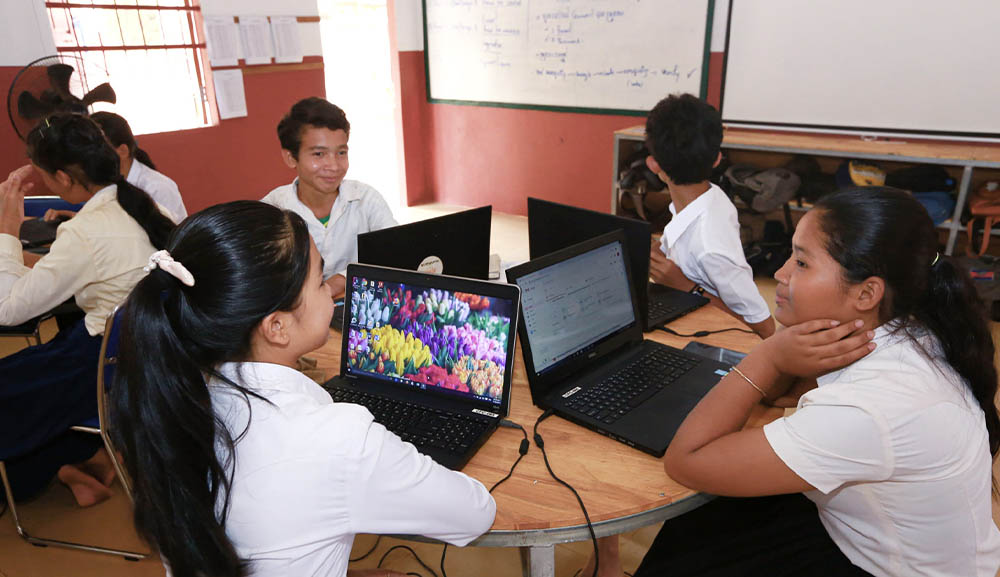Understanding Education in Cambodia: Challenges and Opportunities

Explore the challenges, statistics, and solutions for education in Cambodia, including its levels and future prospects.
Education in Cambodia is essential to molding the country's future. It not only equips individuals with necessary skills and information, but it also promotes society growth. Cambodia has made great progress in education since the 1990s, but obstacles remain. The education system is evolving thanks to the efforts of Ministry of Education in Cambodia. This article examines at the situation of education in Cambodia, education level in Cambodia, and how to increase its quality and accessibility.
The Current State of the Education System in Cambodia
Education system in Cambodia operates under the oversight of the ministry of education in Cambodia. It includes pre-primary, primary, secondary, and higher education level in Cambodia. Despite recent progress, the system faces challenges such as inadequate funding, outdated curricula, and unequal access across urban and rural areas.
Education in Cambodia statistics reveal an improvement in enrollment rates, especially in primary schools. However, the dropout rate remains high at the secondary level due to poverty, social barriers, and insufficient infrastructure. Addressing these disparities is key to fostering a robust education system in Cambodia.
The Role of the Ministry of Education in Cambodia

Ministry of Education in Cambodia plays an important role in policy development, reform implementation, and resource allocation. Its objectives are centered on increasing teacher training, integrating technology, and expanding access to remote communities. While there has been progress, the ministry's governance and accountability need to be strengthened in order to maximize its impact.
Understanding the Level of Education in Cambodia
Here are 4 level of Education in Cambodia
1.Pre-primary Education: This foundational stage introduces children to learning through play-based activities. However, limited resources and teacher shortages hinder universal access.
2.Primary Education: Primary schools cover grades 1–6 and are a mandatory stage. Efforts to improve literacy and numeracy rates have been relatively successful, but many rural schools still lack basic facilities.
3.Secondary Education: This stage includes lower and upper secondary education. High dropout rates, especially among girls, highlight the urgent need to address cultural and economic barriers.
4.Higher Education in Cambodia: Higher education in Cambodia has grown, with an increase in private universities and technical institutions. However, affordability and quality remain key concerns.
Learn more about: Your Guide to an Information Technology Course in Cambodia
The Quality of Education in Cambodia
The quality of education in Cambodia is influenced by factors such as teacher qualifications, curriculum relevance, and classroom resources. Rural areas often face severe disparities compared to urban schools. Additionally, technology education in Cambodia is in its infancy, with limited integration in the classroom. Improving the quality of education in Cambodia requires consistent investment and innovation.
The Importance of Education in Cambodia
Education is pivotal for Cambodia’s socio-economic development. It reduces poverty, promotes gender equality, and fosters economic growth. The importance of education in Cambodia cannot be overstated as it directly impacts the country’s ability to compete in a globalized world.
Cambodia Education Problems and Their Solutions
- Inadequate Infrastructure: Many Cambodian schools operate with insufficient facilities, including a lack of electricity, clean water, and basic classrooms. To resolve this, increased government funding, international aid, and partnerships with local communities are necessary to improve and expand infrastructure development.
- Teacher Shortages: The education system suffers from a lack of adequately trained teachers, especially in rural areas. Addressing this issue involves prioritizing teacher training programs, enhancing teacher education, and offering competitive salaries to attract and retain qualified teaching professionals nationwide.
- Limited Access to Technology: Digital learning tools and internet access are unavailable in many Cambodian schools, limiting modern education opportunities. Bridging this gap requires investments in ICT infrastructure, collaborations between the government and private sector, and providing affordable technology solutions for rural schools.
- High Dropout Rates: Poverty forces many students to leave school early to support their families financially. To reduce dropout rates, policies like financial aid, scholarships, school meal programs, and flexible class schedules can help students continue their education while balancing economic pressures.
- Outdated Curriculum: The curriculum often fails to align with current industry demands, leaving students ill-prepared for the workforce. Updating the curriculum to include STEM subjects, vocational training, and critical thinking skills is essential for meeting the demands of a modern economy.
How to Improve Education System in Cambodia
Here are some ways to describe on how to improve education system in Cambodia, which requires a multi-pronged approach:
1.Increase Government Funding: Allocate more budgetary resources to education to enhance infrastructure and teacher training.
2.Promote Public-Private Partnerships: Encourage collaboration between the ministry of education in Cambodia and private entities to fund schools and provide technological resources.
3.Emphasize Teacher Training: Develop comprehensive programs to improve teaching quality and adapt to modern educational needs.
4.Expand Access to Technology: Invest in digital learning tools and ensure connectivity for remote schools.
5.Enhance Equity and Inclusion: Design targeted interventions to support marginalized communities, particularly in rural areas.
Statistics and Key Achievements
Despite challenges, Cambodia has achieved a literacy rate of over 80% and increased primary school enrollment significantly. Continued investments in infrastructure, teacher training, and curriculum reforms will further enhance these statistics.
Technology Education in Cambodia: A New Frontier
Technology education in Cambodia is gradually gaining traction. Programs integrating IT skills are being introduced, but they are yet to become mainstream. Expanding these efforts can prepare students for a tech-driven future.
Conclusion
Education in Cambodia is at a crossroads. Though progress has been made, considerable challenges remain. Cambodia can fully realize its full potential by resolving concerns such as infrastructure, teacher shortages, and curriculum relevance. Cooperation among the government, corporate sector, and foreign organizations is critical to creating an education system that empowers every child.
Frequently Asked Questions
1.What is the current state of education in Cambodia?
The education system has improved but faces challenges such as inadequate infrastructure and high dropout rates.
2.How does the ministry of education in Cambodia contribute to the system?
The ministry oversees policies, reforms, and resource allocation to improve education nationwide.
3.What are the main levels of education in Cambodia?
The levels include pre-primary, primary, secondary, and higher education.
4.What are the biggest challenges in Cambodia's education system?
Challenges include limited resources, teacher shortages, and unequal access in rural areas.
5.How can technology improve education in Cambodia?
Technology can enhance learning through digital tools, but its adoption is limited due to infrastructure gaps.
More Articles
 20 Nov 2025
20 Nov 2025
GraphQL vs REST: Next-Gen API Trends for Developers
Compare GraphQL vs REST to optimize API performance, scalability and modern application design with best practices for developers.
 20 Nov 2025
20 Nov 2025
Neural Network Programming Beyond Python: Rust & C++
Experience neural network programming beyond Python, powered by Rust and C++ ecosystems built for speed, safety, and large-scale deployment.
 19 Nov 2025
19 Nov 2025
Swarm Robotics in Agriculture & Logistics: Smart Automation
Swarm Robotics in Agriculture & Logistics enhances automation, efficiency, and smart coordination across modern farming and logistics operations.
 19 Nov 2025
19 Nov 2025
Ultra-Low Latency Networks for VR/AR: Optimized Performance
🚀 Discover how Ultra-Low Latency Networks for VR/AR are transforming real-time experiences with 5G, edge computing, and seamless data transmission.